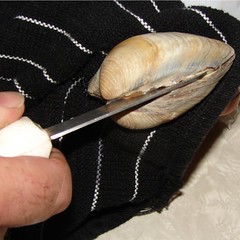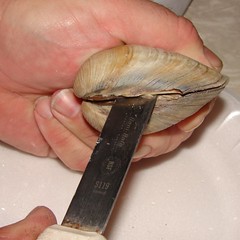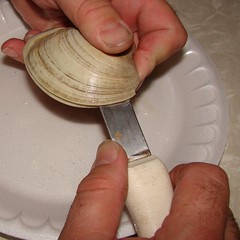It's summertime, and summer eating in New England often includes clams. Soft-shelled clams are steamed, or shucked and fried. Large hard-shelled clams (quahogs) are made into stuffies or chowder. Smaller hard-shelled clams (cherrystones or littlenecks) are often served on the half shell: often raw but sometimes broiled or scalloped or prepared as Clams Casino or Clams Rockefeller.
Regardless of how they are to be eaten, however, many recipes require that the raw clam first be removed from the shell. Soft-shelled clams are easy to open and shuck, because they close relatively loosely and the blade of the clam knife slips in easily to separate the clam from the shell. Hard-shelled clams take a little more work and practice. It can be slow going for a beginner, especially if you've never done it before, but once you know the trick of where to start and have done it a few times you'll be opening clams like a pro.
Before shucking clams, scrub them well under cool running water to loosen and remove any sand or clay that might be sticking to them. With hard-shelled clams, you don't have to worry about grit in the meat. They're closed pretty tightly and they're usually spotless inside.
Regardless of how they are to be eaten, however, many recipes require that the raw clam first be removed from the shell. Soft-shelled clams are easy to open and shuck, because they close relatively loosely and the blade of the clam knife slips in easily to separate the clam from the shell. Hard-shelled clams take a little more work and practice. It can be slow going for a beginner, especially if you've never done it before, but once you know the trick of where to start and have done it a few times you'll be opening clams like a pro.
Before shucking clams, scrub them well under cool running water to loosen and remove any sand or clay that might be sticking to them. With hard-shelled clams, you don't have to worry about grit in the meat. They're closed pretty tightly and they're usually spotless inside.
 Start by covering one hand with a kitchen towel. Grip a clam in that covered hand with the lips of the shell against the heel of your hand and the hinge of the clam towards your fingertips. With the other hand, hold the sharp edge of the clam knife against the hinge, pressing on the unsharpened back of the blade with your fingertips. Use the towel-covered hand to squeeze the clam knife and the hinge of the clam together until the blade bites into the hinge.
Start by covering one hand with a kitchen towel. Grip a clam in that covered hand with the lips of the shell against the heel of your hand and the hinge of the clam towards your fingertips. With the other hand, hold the sharp edge of the clam knife against the hinge, pressing on the unsharpened back of the blade with your fingertips. Use the towel-covered hand to squeeze the clam knife and the hinge of the clam together until the blade bites into the hinge.The towel is there to protect your hands from a cut if the knife slips. When you gain more experience and confidence, you may decide for yourself whether or not the towel is necessary.
 Still holding the clam in your toweled hand, use the clam's hinge as a pivot to bring the tip of the knife inward, forcing it into the tight gap between the top and bottom shells. As the knife goes into the clam, move the handle downward so that the tip of the knife contacts the inside of the top lid.
Still holding the clam in your toweled hand, use the clam's hinge as a pivot to bring the tip of the knife inward, forcing it into the tight gap between the top and bottom shells. As the knife goes into the clam, move the handle downward so that the tip of the knife contacts the inside of the top lid. From this point on, it's a lot easier and you probably won't need the towel to help you hang onto the clam. Use the tip of the knife to sever the first of two adductor muscles. This will immediately loosen up that side of the clam, and the seam between the top shell and the bottom shell won't be as tight. You can take the knife out now, flip it, and reinsert it so the sharp edge is pointed in the other direction.
From this point on, it's a lot easier and you probably won't need the towel to help you hang onto the clam. Use the tip of the knife to sever the first of two adductor muscles. This will immediately loosen up that side of the clam, and the seam between the top shell and the bottom shell won't be as tight. You can take the knife out now, flip it, and reinsert it so the sharp edge is pointed in the other direction. Slide the knife along the seam between the shells. As you move the blade along the seam, keep the tip of the knife in contact with the inside of the top shell. Clams cling to both halves of their home, and it's necessary to loosen their grip here as you go along.
Slide the knife along the seam between the shells. As you move the blade along the seam, keep the tip of the knife in contact with the inside of the top shell. Clams cling to both halves of their home, and it's necessary to loosen their grip here as you go along. Continue along the seam to the other side of the hinge, where you'll find the second adductor muscle. Sever this muscle with the tip of the knife against the inside of the top shell, just the way you did with the first one. Once you've cut the other adductor muscle, give the knife a twist and the clam will open easily.
Continue along the seam to the other side of the hinge, where you'll find the second adductor muscle. Sever this muscle with the tip of the knife against the inside of the top shell, just the way you did with the first one. Once you've cut the other adductor muscle, give the knife a twist and the clam will open easily. And there you have it: a perfectly opened cherrystone clam, ready to use in a recipe, or simply enjoy as is - raw from the half shell.
And there you have it: a perfectly opened cherrystone clam, ready to use in a recipe, or simply enjoy as is - raw from the half shell.The method for opening a hard-shell clam is the same no matter what size they are - from the biggest quahog to the most delicate littleneck. The first time you try to open one, take your time and go slow. It's going to take a few tries to get it just right. Sometimes, one of the shells might even crack or break; if so, don't fret about it, just finish that one and flip it over so the unbroken shell is on the bottom. Trust yourself to get better at it as you practice and soon you'll be shucking clams as fast as the guy putting them on ice at the raw bar.
.

7 comments:
thanks, it helped a lot
Excellent instructions! Thanks very much.
Thank you so much !!!
? BThanks great instructions BON APPPETIE
Lou/Deb
Thanks great instructions BON APPPETIE
Lou/Deb
Thanks for the clam opening instructions. It must be added that some clams in New Jersey will not open to any finger pressure. Banging the knife in the hinge slightly opened slot will work. (It's a good professional clam knife.)
Thanks so much!!! Great instructions!!
Post a Comment